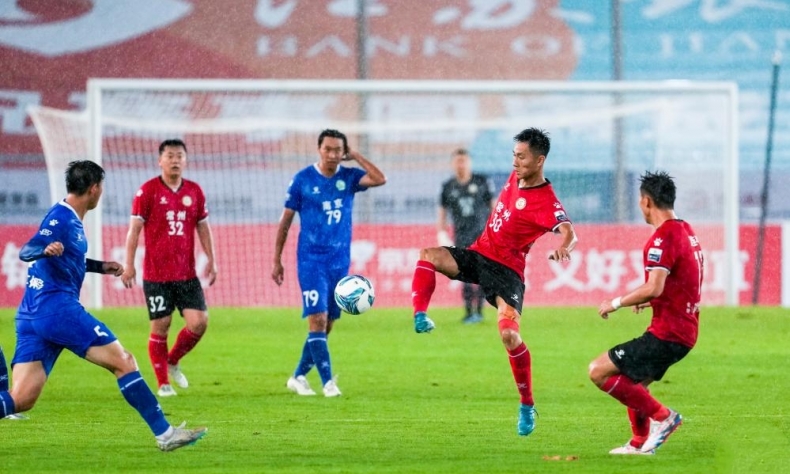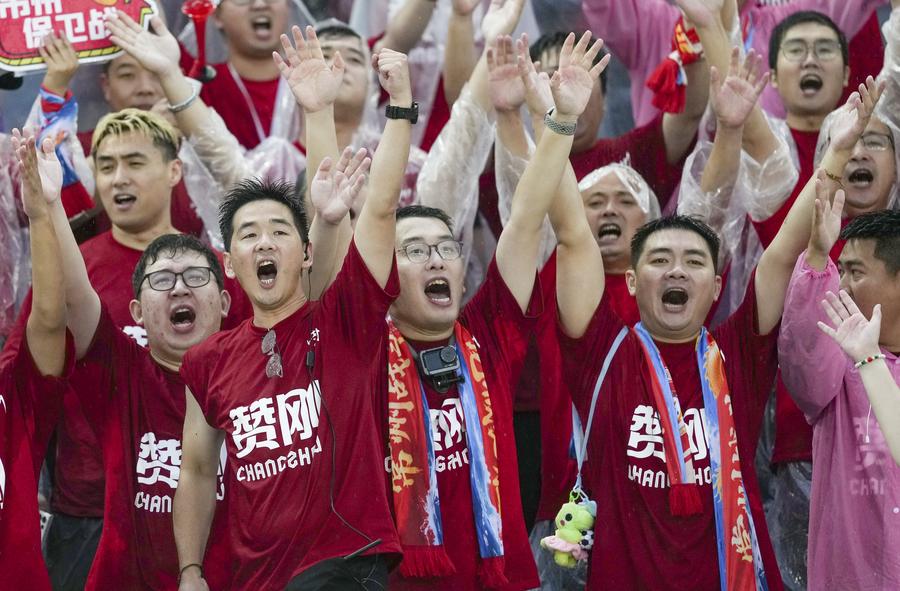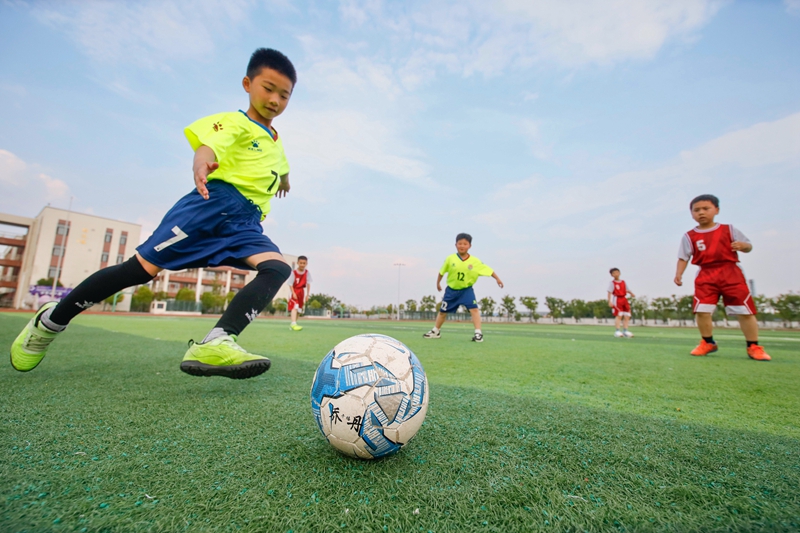How Jiangsu’s Grassroots Soccer League Has Become the Nation’s Hottest Sports Craze

Jiangsu Soccer City League (JSCL) integrates regional cultural elements, including local characteristics, historical heritage and regional cuisine, into the events, elevating it from a mere sporting event to a vehicle for regional cultural identity, attracting more attention from the public.
After taking his teenage son to a match in the Jiangsu Soccer City League (JSCL), affectionately known as the “Su Super League” or “Suchao,” in mid-May in Huaian, Jiangsu Province, Gao Qi has heard his son repeatedly express a desire to go watch another Suchao game. However, securing a ticket has become increasingly difficult, as the inter-city matches have become a bonafide sports sensation, not just in the province but nationwide.
This first urban soccer league in Jiangsu started in mid-May and will last for seven months, with 85 matches between 13 teams, each representing a city in Jiangsu. So far, its attendance has surpassed that of some established professional leagues.
The league teams comprise not only professional players but also amateur participants, including business owners, university students and high school students.
The JSCL has become popular not just because of the matches themselves, but also as a meme factory, creating shareable, laugh-out-loud moments that spread like wildfire online.
Wang Xiaowan, Vice President of the Jiangsu Soccer Association, expressed in an interview that he did not anticipate the league would become so popular. “In our experience, soccer relies heavily on fans, but the biggest highlight of this tournament is that it has also drawn the attention of people who typically don’t follow soccer,” he told media.
“Originally priced at 5 to 10 yuan ($0.7 to $1.4) each, the tickets have skyrocketed on second-hand trading platforms, selling for between 100 and 300 yuan ($14 to $42) per ticket, with some sellers even asking for as much as 600 yuan ($83),” Gao told Beijing Review. “Despite these inflated prices, demand still far exceeds supply.”
The fun
The JSCL has become a phenomenon in China’s sports realm. On Douyin, the Chinese version of TikTok, the hashtag “JSCL” had raked in 910 million views as of early June, generating unprecedented buzz. In response to user demand, Hupu, a popular Chinese sports commentary and news platform, quickly added a dedicated section for the league, which saw over a million visits on its launch day alone.
The matches have been held at weekends. In the second round of the JSCL (May 24-25), the average attendance for each match reached 9,852, exceeding that of the professional national league during the same period. The excitement rose further in the fourth round (June 14-15), with the attendance of each match averaging at 25,000 and that of the match between Xuzhou and Zhenjiang hitting 30,823. Meanwhile, the game at the Wutaishan Sports Center in Nanjing between Nanjing and Wuxi saw all tickets sold out within seconds, resulting in an actual attendance of 15,669, setting a record for the venue. A seasoned fan from Nanjing remarked, “Tickets for a Jay Chou (who is considered one of the most influential artists in the Chinese-speaking music world, widely referred to as the ‘King of Mandopop’) concert aren’t this hard to get!”
What’s fueling this frenzy is more than the pure love for soccer among fans. A major factor is the league’s knack for creating meme-worthy moments. For example, matches between teams of economic powerhouses like Suzhou and Nanjing aren’t just games—they’re trash-talking events, with fans joking, “Allow me to remind you who’s the boss.”
The league’s “slogan”—”Friendship is 14th, winning is first”—is visible on billboards in shopping malls across Jiangsu, playfully mocking the usual sportsmanship cliché of “friendship first, competition second.”

Many fans have expressed their excitement, saying, “We came for the soccer and stayed for the ruthless banter,” and “Finally, a league that admits we just want to crush our rivals!”
The phrase “14th-Place Friendship” for a league participated in by 13 teams has become a catchphrase for competitive spirit, even used by fans outside Jiangsu.
Up to standard
In an unprecedented move, JSCL has completely broken down the barriers between professional and amateur players, emphasizing community involvement. Each city’s representative team is composed of diverse members. Players include 29 professional ones, 154 students and 337 other residents from various professional backgrounds, with ages ranging from 16 to 40—the average age being 24.
To ensure fairness, the league limits the number of professional players on each team to three. Players of a team must either be Chinese citizens who have the permanent residency of the city represented, or have studied in the city for over five years, or have played with one of the city’s soccer clubs for at least five years. This design maintains competitive standards while encouraging public participation, truly making it a league for everyone.
According to Wang, the league is also supported by a professional competition system. “We received strong backing from the Chinese Professional Football League, and our standards for organizing the event are quite high,” he said, adding that this includes a data system for the event, as well as appointed technical officials and referees, all adhering to the standards of professional leagues. The schedule is also managed using software from the Chinese Professional Football League, with some matches officiated by referees from the Chinese Super League, the top professional soccer league in the Chinese mainland.
The overwhelming popularity of the league has exceeded expectations. Wang mentioned that there were initial concerns about potentially low attendance—at first, the requirement for a venue was a minimum of 2,000 seats, but due to the explosive popularity of the games, some cities moved them to larger sports centers. After the second round, many areas felt their venues were too small, leading to the use of bigger event centers for the third round.
Yet the league’s attractiveness is no accident. For many years, Jiangsu has been a fertile ground for soccer. Back in 2017, the province implemented a plan on soccer reform and development, which outlined several goals to be achieved by 2025, including the establishment of six to seven professional soccer clubs, 100 demonstration schools for soccer talent development, 3,000 schools with soccer programs, 4,000 registered amateur soccer clubs and 8,000 pitches.
In Jiangsu’s provincial government work report for this year, soccer was mentioned twice, identifying city leagues as a new highlight for integrating culture, tourism and sports, while accelerating the revitalization of the three major ball sports—soccer, basketball and volleyball.

Beyond the pitch
The JSCL’s popularity has invigorated tourism in Jiangsu. Official data showed that host cities welcomed over 180,000 fans to watch the matches during the Dragon Boat Festival holiday (from May 31 to June 2 this year).
Data from online services provider Meituan revealed that in one week in early June, searches for “JSCL” on its platform surged by over 16 times compared with the previous week. From June 3 to June 8, bookings for tourist attractions in Jiangsu increased by 305 percent compared with the same period last year.
Local traditional specialty foods have been flying off the shelves. In Changzhou, a “9.9-yuan ($1.4) ticket plus dried radish with fried rice” combo has doubled online sales of local dried radish brands.
After Nantong defeated Taizhou 4-0 and Nanjing won 1-0 against Wuxi on June 1, interest in the local cuisines of Nantong and Nanjing noticeably increased. Data from Meituan showed that on June 2, searches for “Nanjing salted duck” rose by 74 percent compared with the same time of the previous week, and orders for “salted duck” meal combos increased by 58 percent. Additionally, searches for “Nantong dim sum” surged by 367 percent.
Moreover, searches for keywords related to “soccer bars” and “match-viewing bars” have seen a considerable increase.
On an online retail platform, a JSCL fan jersey has sold thousands of pieces, becoming the top-selling new soccer kit. Team logo stickers and canvas bags have also surpassed usual sales. The merchandises are mainly shipped from Nanjing, Yancheng and Changzhou.
Cities like Changzhou, Xuzhou and Zhenjiang have offered free admission to tourist attractions for visiting fans. Yancheng, Nanjing and Taizhou have created travel packages combining match tickets with sightseeing and dining offers.
The “soccer fever” sparked by the league has also heated up the stock market. On the morning of June 5, sports-related stocks rose by nearly 3.4 percent, reaching a six-month high.
Song Xiangqing, Vice President of the Commerce Economy Association of China, told newspaper China City News that the JSCL integrates regional cultural elements, including local characteristics, historical heritage and regional cuisine, into the events, adding a unique cultural charm to the league. This model elevates it from a mere sporting event to a vehicle for regional cultural identity, attracting more attention from the public, according to Song.
Wang believes that the league will gradually move toward marketization in the future. However, at this stage, he stressed, it is essential to analyze and assess carefully how to effectively manage broadcasting rights, sponsor returns, licensed merchandise and related commercial events.
Observers from other regions now sense an opportunity to upgrade their regional soccer competition systems. For instance, Chen Zijia, a staff member with the Shanghai Soccer Association’s competition department, recently told media that Shanghai authorities are planning to emulate the JSCL model, hoping to host community-involved soccer competitions in the metropolis.
 Facebook
Facebook
 Twitter
Twitter
 Linkedin
Linkedin
 Google +
Google +










